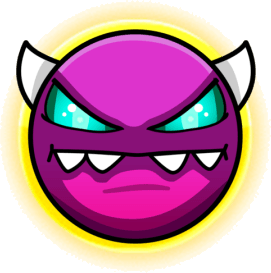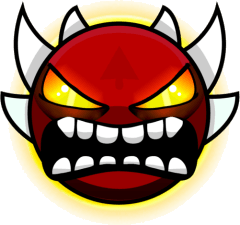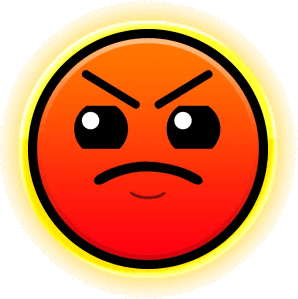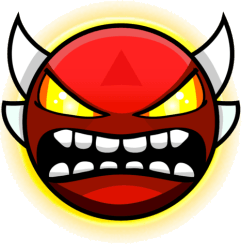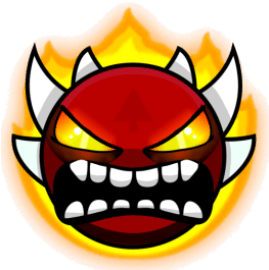Moderator
Rating Curve
Filters
Reviews
Levels like these take me back, and it's crazy to see how prevalent a lot of the fundamentals shown in Ebb still are today. I'm a big fan of how SirHadoken uses specific shapes within the structures in order to make them feel like they "fit together" nicely - particularly, around 0:25 where multiple layers are introduced. I like how the inner highlights of the rectangle-in-rectangle structures are hue shifted slightly to make them stand out more and create a more distinct set of layers within the blocks, and the black corner pieces used as an accent also accomplish the same goal quite well. I'm especially a fan of the "stacked" structures with multiple vertical layers, as the contrast between their base colours (including black and white) and the often complementary outline colour makes every detail stand out very nicely against the simple backgrounds.
The structuring also makes the gameplay very intuitive, a concept that even nowadays I still don't see done very often in easier levels. Black groundspikes are used to fill spaces between structures, but only when the player might expect a path to be where the groundspikes are, which does a good job making the intended path clearer while also filling some excess negative space. This is most prevalent around 0:53 with the more open, blocky structures in the UFO part, and particularly here it works well because of the high verticality of the part creating some ambiguity in regards to the intended path with traditional structuring. SirHadoken also uses some translucent bricks to "connect" many of the structures vertically, which grounds them to each other and makes the level as a whole feel more complete and reduces the feeling of structures "floating" in space with no attachment to anything else in the level. (edited)
Ebb isn't perfect; many of the colour choices are pretty jarring (especially the complementary ones) or washed out, the air decoration lacks much thought behind it and consists mostly of randomly placed saw decoration, and the structuring shape does get quite repetitive as it rarely changes throughout the level. However, given the limited editor tools available, and the general state of created levels around mid 2.0, Ebb is quite impressive and very ahead of its time, and demonstrates a good understanding of many design fundamentals that are still in use today.
I've always felt QuazeryIceCube has a fantastic eye for capturing a song's essence really well in their levels, and frozen refraction is no different. The song's minor key and somewhat dissonant synth leads create a colder, more desolate atmosphere, and this translates through the blue/purple colour scheme and very open structuring style of the level that lets the backgrounds shine. I really like how the dash orbs are used in the first drop; the synth wavering comes through in the slopes that redirect the player around, and when the pitch of the synth changes, the player moves around with it. A really cool touch is that cube portals are used for the more subtle pitch shifts during this section, which is a really smart way to stick to the concept while also adding some more variation.
The same ideas are present in the second chorus, but this time the song is far more layered, with way more overlapping synths and instruments. The glowy bar locked to the player splits into two during this second chorus, yet remains audibly and visually very well connected - the split visuals create very bright spots when they overlap, which are generally in time with the most intense sections of the song, and both halves are locked to either the player or the gravity portals. When both parts are combined with this flowing, flashing background of cubes that Quazery uses, it creates such a unique, cold yet lively atmosphere that I've almost never seen done to this level before.
Aside from this, Quazery also represents change in audio exceedingly well. During the buildup to the second drop, the song's intensity slowly increases as the volume of the background synths increases, and this translates via a glowing aura around the player that slowly brightens. The part stays the same throughout, which is an approach I like because only one element of the song is actually changing, and thus only one element of the level changes (significantly). In the first part, as the song starts to pick up, rainbow objects and bright particles are slowly incorporated in time with the bright synth pulses that are introduced, giving the trippy foreground/background masking effect in the part some much needed variation visually. Overall, frozen refraction is a fantastic example of how I like to see song representation approached, and one I would send for Epic. I would encourage many creators to try their hand at incorporating these ideas into their own levels, as I'd love to see how it affects them.
Dead Of Night is tough to describe, because the sheer scale of 64 individual levels puts it in a league of its own in terms of room platformers. Before talking about the individual levels, the single thing that I think makes this concept of a massive, multi-level room platformer work at this scale is DON's level select. The UI is smooth and intuitive, and the ability to select and practice individual levels is incredibly helpful to players attempting to tackle this level's 2+ hour playtime. I love how each level is given its own portrait and title card - giving players a glimpse into what each one offers can be a really nice way to help them pick where to start, or recognise ones they already enjoy. Every single creator is given their time in the spotlight, in a way that's still intuitive and approachable for the average player due to the menu UI's design.
The individual levels themselves are generally high quality, but each one tends to stick to one specific idea such that almost all of the individual parts stand out from each other. I particularly like the mouse pointer gameplay and constant early internet culture references in mbed's part, or the complete gameplay innovation to make a playable version of Fortnite in Culuc's part. Every single part has something to offer, making this behemoth level never really feel stale during playtime - a massive achievement considering DON's length.
I really have no complaints with this level. Limitations surrounding object count causing memory leaks and the overall massive playtime mean that I do agree with the Feature rating it received, but this is an incredibly well organised experience that feels like a tribute to everything that the GD community has accomplished. There's something here for everyone, and I think that is quite awesome.
April Foole isn't a particularly serious level, so many of its elements are either not worth touching on here or can be chalked up to being the way they are for the sake of humour. However, especially for an April Fool's level, I really wish this level just picked one bit and went with it. Some of my favourite joke levels out there are the ones that just send it really hard on one very specific joke (think Your Brain On Drugs by Jayuff), where it's clear the creator really believed in their joke and wanted to let it shine. Throwing together a bunch of random bits of internet humour/culture into a ragtag mess doesn't get very far in the realm of making a level funny or memorable, and in my case really only served to make me cringe through a minute of level that feels very half-hearted in its attempt to be a joke in the first place. In my opinion, if you're going to try and be funny in a level, pick one bit you enjoy and commit to it fully for the level's entire length. The method that's used to do this is up to what the bit itself is - the "fake" bossfights and one-liners in Your Brain On Drugs wouldn't work as well for something like a You've Been Trolled level - but as long as you commit to it, the chance that the humour will land is a lot higher, and the chance that the level will feel like a proper, cohesive product is also a lot higher.
For lack of much in the way of a better description, Subpar feels like a 2020 daily level. There's some good to be found here, but a lot of it ends up washed out in a sea of deja vu over so many of this level's major elements being played safe.
The designs, structuring and colour scheme of this level stay consistent throughout its length, which is commendable and the metallic blue, angular and vaguely industrial theming is far from bad - in fact, I quite like how it's executed. There's a good balance of detail between the structures and the air deco, with some negative space being left near the top of the screen, but the rest generally being filled with simple backgrounds or effects such as rising bars of glow. When combined with decent enter/exit movements on the structures, Subpar feels quite dynamic to play and stays consistent enough to feel very cohesive throughout its runtime.
I'm also a fan of the slight hue shifting that's done in the first part of the drop, where some of the brighter highlights are shifted 30 or so degrees either up or down to make them stand out from the base designs of the part more. The glow bars that move into place inside gaps created by two pillars are nice to provide a visual connection point between the structures, and make the player's intended path clearer. The common theme with all of this feedback, though, is that it's quite nondescript and can be applied to so many levels to varying levels of accuracy. Subpar really has nothing that makes it stand out; yes, a lot of the individual elements within it are quite good, but I feel like I've played this exact level hundreds of times at this point in my journey in Geometry Dash. In the current creating climate, if you want to aim for anything above permanent mediocrity, it's important to develop something unique to your style that helps you stand out from the pack, whether that be a certain style of structure deco (Icewither's very angular, pipe-like designs are a good example of this), specific usage of movements and structure shapes (2.0 Nasgubb or Namtar), or a specific type of effect that you like (Konsi popularised many of the glow-based effects that would go on to make up the "russian glow" style). I'd recommend pushing your own limits and attempting to expand on what you're comfortable building in future projects to find that thing that helps you stand out from the rest.
tran la luot takes a pretty interesting approach to controlled chaos that mostly works, with some caveats, although it definitely lacks in execution in some areas. The way emily419 showcases the overdriven, compressed bells in the predrop is quite nice, as the level slowly vibrates itself apart at the seams as the bells get more intense before jumping into complete, rainbowy chaos at the introduction of the backing synths. This contrast combined with the full-screen glitch effect is a great build and release of tension, and makes the transition between the two parts feel just as impactful visually as it does audibly. I particularly like the usage of the spinning circular setpiece asset in the background, almost wheel- or portal-like, as its massive size and constant movement means it does a good job of representing the grandiose, buzzing backing synths of this part.
I also like many of the individual effects in the drop, and their usage is generally solid. The tight, blue-purple glitching effects are a good counterpart to the bitcrushed snare drums, and the heavy use of glitching overall combined with the scattered single blocks for structures and the RGB colour scheme feels like the level is breaking apart, which feels quite fitting with how loud and intense the song is. The rotating messes of lines towards the end feel even more like the level is pulling itself apart at the seams, which is a nice addition to contribute to the level's high tension throughout the drop.
Unfortunately there is very little to tie each individual element of the level together into a cohesive product, and even then many of the elements seem misplaced or desynced from the elements they feel like they're meant to represent. The first two parts do have quite a strong visual identity, as the aforementioned vibrating movement is carried between parts in the form of flower structures and glitching masses of lines on the top and bottom of the screen. The rest of the parts don't really share anything in common aside from the general "glitching" theming; the designs and structuring tendencies are completely different from part to part, there's little consistency with colour scheme or gameplay style, and even the effect usage becomes really inconsistent at the end because it stops being attached to specific elements of the song as the first half of the drop does by attaching the glitches and flashes to the percussion. I would recommend having a more concrete idea in mind as to a level's overall progression before going into decorating it, as realistically any form of recognisable theming would have done wonders to improve this level's overall cohesion, be it design tendencies, structuring, colour scheme, effect usage or background detail. However, this is still an impressive showing for emily419's first created extreme demon, and has a lot going for it in terms of its ideas with design philosophy, "setpiecing" specific assets and effect work. I would recommend this for Star Rate.
More than anything, this level confuses me. GloomIX is part Clubstep remake and part 1.9 "hell level" with more modernised designs, and just keeps throwing curveballs at the viewer during its runtime.
I honestly appreciate this level's willingness to just, do shit. It's a surprisingly well put together level considering how all over the place it is; I like how the designs in the first part progress from flat slopes with metal highlights to the flat block memory cube maze with metal highlights, and I also like the usage of sawblades for structure corner deco consistently throughout the level, it helps give GloomIX a bit more visual identity. With that said, though, this level's style and details are constantly shifting; the drop sections sort of remind me of Clubstep Nightmares by Zobros, except red, and then there's a random Nine Circles section thrown in, and then a 1.6-styled cube maze, and at the end there's a giant Winnipeg Jets logo in the middle of the screen out of nowhere. It genuinely feels like a fever dream at times because of how little sense a lot of the twists and turns in the level make, but I have to admit that each individual part does look decent, and the unexpected twists make the level pretty damn memorable.
With that said, I wish this level picked a clearer direction in regards to how authentic it is to a certain era of 1.9. The "era" of GD that each part is most reminiscent of is probably the most inconsistent thing about the entire level, as it jumps around between late 1.9 (beginning), early 1.9 (late midsection), 1.6 (middle memory cube), 1.8 (beginning of the drop) and even some 2.0/2.1 near the ending. Picking a specific time period and focusing on it would likely have made the approach taken to the visuals feel a lot more cohesive, even if the actual parts were as incohesive as they currently are, because at least all the visual decisions taken would make more sense for a specific time period. Considering this was built with the 1.9 editor, something like an early-mid 1.9 megacollab might have hit the mark best, and allowed the creators the most freedom in terms of the fever-dream-esque approach taken with this level.
Regardless, GloomIX is quite a funny level, and one that I find pretty memorable despite the glaring flaws. I would really like to see more attention to detail in regards to authenticity, and more care taken to match parts to the time period they're roughly modelled after. I'd recommend this for Star Rate.
Hazard Duty Pay is an attempt to emulate the successful aspects of In Silico by Rafer, but is unsuccessful in most regards. The main thing that I think made In Silico work so well is how well the gameplay integrated with the level's concept - the labyrinthine tunnels, constant falling and crumbling blocks, warnings and flashing lights all have very strong, obvious thematic connections to the "escape the facility" themes of the level, and combined with the intense song made for an awesome escape sequence. Summed up, Hazard Duty Pay feels like a vapid attempt at recreating this feeling. The gameplay is a particularly sore spot for me; the difficulty in this level comes with (theoretically) much more tightly packed, claustrophobic gameplay, which in theory could work quite well for the escape sequence idea, but the structuring largely does not feel "solid" or labyrinthine in the way In Silico's does, largely due to the more traditional, less naturally-shaped structuring approaches used as well as the lack of contrast and highlights in many of the structures (think of the way In Silico used huge machinery parts or rock tunnels to guide the player), which leaves the gameplay feeling much less intuitive and actually less claustrophobic than In Silico despite the increased difficulty.
The decoration is generally okay, I do quite like some aspects of it. The designs overall have some pretty decent showings; I'm a big fan of the dark, sloped mechanical/electrical blocks around 0:11 and the giant sloped structures at 0:50, as these feel the most to me like an extension of Rafer's style, building that vision into something new with a biomechanical theme that is still distinct enough to give each respective part its own identity (particularly the ending chase, many of the designs feel rocky and glowing orange like the inside of a volcano, which is nice for the climax). However, these approaches are highly inconsistent, and often a lot of the visual elements feel like they fall back on a more traditional glow-design style that creates two somewhat distinct styles that are mish-mashed together in each part. This sticks out the most to me in the part at 0:19, where the flat, angular metal structures do not mesh well whatsoever with the larger, less angular filler structures; they fill different roles, one being a highlight and one being a base, but their physical placement never overlapping and clashing colour choices mean the two do not feel like they should be together in one part.
I see the vision with Hazard Duty Pay, and in some ways it's successful in delivering on expanding on the vision brought on by In Silico, but overall I find this level to be a letdown. The gameplay is underwhelming and one-dimensional, and the decoration misses the mark on most of the elements that made In Silico such a good level to begin with, while really not adding anything new to the table to compensate, leaving Hazard Duty Pay as sort of a vapid middle-ground remake attempt that does not stand out to me in any way.
Slasher has a lot of clean, classic 2.1 design elements reminiscent of creators like Tongii and MrSpaghetti. This is quite a populated field of levels, so let's see what Slasher does to sell itself as something to be played.
Firstly, I'm a big fan of each part having one specific "set piece" element. The pulsing static effect in the coloured highlight blocks in the first part, and the large rotating gears in the second part are synced nicely and give each part a nice visual anchor for the player's eye to follow. They also help each part stand out from the next, as most of the structuring and air deco are built around these elements, most noticeable with the platforms wrapping around the aforementioned gears, helping them stand out further.
The level's energy is solid overall too. The upbeat, fast-paced song is conveyed through a mix of bright background flashes in the predrop, and adds in moving glow bars, blur and moving objects in the drop for further intensity. While I find the blur is used too heavily and stands out as not being implemented particularly well, the other elements do a nice job at conveying the song's energy.
Unfortunately, all of these are very basic and have been done again and again in other levels. MrSpaghetti in particular tends to use many of these (often grouped together) in his own levels. They definitely do work, but I'd like to see more innovation from bluey0shi in their designs and how they express the song. I've always loved how levels like Mechanical Showdown by Tongii approach energy - quite minimal pulsing, and most of the energy carrying is done through gameplay difficulty, gamemode selection (asymmetrical dual as the "finale"), moving structures and rising complexity in structuring and interior designs as the level progresses. Other creators like Namtar and Nasgubb frequently execute/have executed this sort of "design progression" with great success in the past, and I find it to be a much more effective form of song expression because of how it intertwines each element of the level with the song's rising and falling intensity through feeling (increased complexity relating to increased energy, etc), instead of forcing it through pulses and fast movements.
Slasher isn't a bad level by any means, but it leaves a lot to be desired. I would recommend it for Star Rate and hope to see improvements from bluey0shi going forward.
Adelucid may be the best list demon out there currently. It has one of the most unique approaches to both its gameplay and decoration I've ever seen out of the top demon scene. This song is most definitely a weird one to work with, having quite expansive and serene instrumentation alongside gritty, neurofunk-esque production, but MannyHeffley made it work.
The gameplay is mainly what represents the drums, and by and large it does an excellent job of this through a mix of movement and click sync. MannyHeffley's approach to click sync is unique, as not all of the clicks are actually synced, but when combined with the icons' movement (particularly the low gravity dual in the buildup) pretty much every percussion noise is accounted for. All of this is done without any particular use of flashy effects or high speeds to convey the song's energy; it's purely done through movement, clicks and usage of dual portals where many sounds overlay each other at once in the song, and I absolutely adore this approach because of how strongly connected it is to the song while still being open enough to allow for the expansive, sweeping structures MannyHeffley uses.
The decoration is also absolutely fantastic. The trumpets, saxophones and piano that make up the bulk of the song's melody feel expansive and delicate, almost reminiscent of royal fanfare, and this comes through in the massive swathes of brush-like layers that make up the level's structures. The structures, foreground and background decoration all do this at points throughout the level (albeit not all three at once in order to preserve some separation between gameplay and decoration, which is nice), and the pulsing, organic shape of the layers of colour makes the whole thing feel like waves of fabric or sunlight rippling through tree leaves. I especially love the background in the drop's second half; the huge streaks of reddish-orange feel like petals or an abstraction of a sunset, and contrast nicely with the mainly pink structures. The whole level has a sense of grandiosity to it due to the slight camera zoom and the sheer size of most of the assets used that works really well with the aforementioned melodic elements of the song, and the whole experience is genuinely mesmerising.
This is a rare case where I have nothing bad to say about a level. Granted, this is too hard for me to play and properly judge the gameplay's playability, but regardless this is my favourite list demon of all time and I would recommend it for Mythic. Fantastic work from MannyHeffley and I am incredibly excited for their next projects.
GDPR Cookie Consent
Hyperbolus uses cookies and local browser storage to enable basic functionality of the site. If we make any changes to these options we will ask for your consent again.
sorry about this gang
